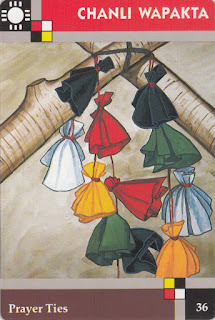As it turns out, love is all about the brain – which, in turn,
makes the rest of your body go haywire. ~Katherine Wu
According to Dr. Helen Fisher, romantic love can be broken down into three categories: lust, attraction, and attachment (each fueled by different hormones). If a relationship continues over a period of time, dopamine (motivation, excitement) decreases while oxytocin and vasopressin (bonding, affiliation, nurturance) increase, thus allowing attachment and the chance for a long-term relationship. Gosh, that sort of takes all the roses, candy and Valentine cards right out of the equation, doesn't it? Well, not really. All those hormones still react according to the thoughts we have and the actions we take, so becoming self-absorbed is liable to dry them right up. Prayer Ties are a visible wish for the well-being of others and an expression of gratitude. They are a way to knock us out of our self-centered orbit and consider the needs of others. Probably would give those hormones a boost too.makes the rest of your body go haywire. ~Katherine Wu


Whew, that's a fairly passionate embrace. I wonder if her study indicated which hormones were present in which gender? Women and men for the most part do not experience the relationship the same. Guess that is why sometimes it hangs by a wing and a prayer
ReplyDeleteAll the hormones are present in each gender, though usually more estrogen in females and more testosterone in males.
DeleteTestosterone and estrogen drive lust; dopamine, norepinephrine, and serotonin create attraction; and oxytocin and vasopressin mediate attachment.
looks scratchy to me. I also hate sand everywhere :) Relations for me come down to effort expended. I've finally had to accept my nature to not have the energy for very many relationships.
ReplyDeleteMy first thought was about poison ivy! I agree, relationships require attention and work.
Delete